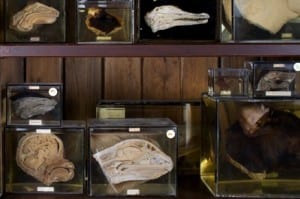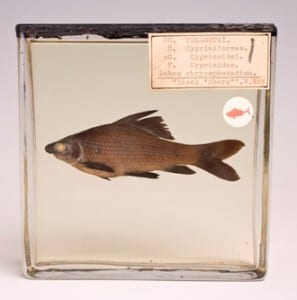So when is natural history art?
By Jack Ashby, on 19 September 2012
Before I start, just to be clear, I’m not one of those scientists who hates art, or is snobbish about the semi-defined/awe-and-wonder/expressive/cheeky-subversion/I-don’t-care-if-the-viewer-doesn’t-understand kind of thing that some artists get up to. Not at all. I think it’s great. In fact, I work hard to incorporate a lot of art into programmes at the Grant Museum.
Over the last couple of weeks two of the city’s biggest block-busters finished – Animal Inside Out at the Natural History Museum and Damien Hirst at the Tate Modern. They were both excellent.
Much has been written about the cross-over between art and natural history, particularly when traditional scientific museum practices are replicated in art. What makes one art and one science?
The obvious answers relate to the intentions of the artist and the interpretations of the viewer.
Hirst’s cows
Copyright law and Grant Museum budgets prohibit me from including a picture of Damien Hirst’s Mother and Child Divided 1993, but if you don’t know it you can imagine a cow and a calf each cut in half in four tanks. Oooh! Art. Obviously. It’s amazing, full of imagery, suggestion and meaning.
Now consider the Grant Museum’s bisected heads pictured here. Aha! Science. Quite clearly. Beautiful, intriguing, inviting closer investigation. They were prepared by Sir Victor Negus at the Ferens Institute of Otolaryngology – they allow the study of structures in the nose and throat across a huge range of taxa. Yep. Science, for sure.
But no doubt Hirst has seen these – his studio is only round the corner. The technique is the same, they look the same. Are they the same?
You tell me. Having walked between the two halves of the cow I, like everyone else, was inspecting recognisable aspects of the anatomy. “Gee whiz! Look at the stomach” was the paraphrased response of about half the people I eaves-dropped on. That’s science.
Ever milked a cow? I have – it feels like a thin rubber bag filled with liquid, which you pinch a bit off of and squeeze out the contents. It doesn’t feel like a boob – I was surprised at the time. At Tate Modern’s Hirst retrospective I was, for the first time, given the opportunity to see an udder cut in half, and try to work out the physical reality of my milking sensation – I performed a scientific investigation.
At first glance, then, the piece is art – “ooh yes, mother and calf seperated – a nice pun filled with suggestion”, but then people start to investigate it closely and look at its anatomy. Surely by this point the artist’s intention is forgotten and the viewer’s interpretation turns it into a natural history museum object.
Hirst’s fish
Wandering around Hirst’s natural history works, I began chiding myself for failing to switch off my museum-visitor-setting. I was searching labels for species names (common ones, not Latin ones), which I know isn’t the point of his work – it’s force of habit. But as I loitered by The Physical Impossibility of Death in the Mind of Someone Living 1991 – a fluid preserved shark in a container that is only rivaled by the Natural History Museum’s giant squid, I heard ten or twelve others asking the same question. (If you care, it’s a tiger shark).
Beyond it’s title, this specimen should be in a natural history museum, it’s just the fact that we can’t afford tanks that size which makes it art.
And I’m not exaggerating when I say that nearly everyone stood at Isolated Elements Swimming in the Same Direction for the Purpose of Understanding (Left) and (Right) both 1991 pointed at one of the fish and asked “what is that?”
That was also a common question in the butterfly house in In and Out of Love 1991 (but to be honest those places are always under-interpreted, even at zoos and museums. I can hardly ever find the ID guide).
Plastination at the Natural History Museum
Animal Inside Out was the most jaw-dropping exhibition I have ever seen. My office has a real rhino as one of its walls, so I am not easily impressed by specimens. A full size plastinated elephant, slightly exploded to see various internal bits was literally wonderful.
All through this exhibition the specimens were a feat of dexterity, engineering AND evolution, backed up by beautiful graphics. My main criticism is that they weren’t interpreting in the text the anatomy they displayed in the specimens, which seemed like a missed opportunity. But my overwhelming emotion was inspiration and awe – more so than anything I’ve seen in any other museum or gallery.
Everything that was written in Animal Inside Out was about natural history – it was a natural history exhibition interpreting the specimens with the stories of the species they represented. And yet no-one would argue they weren’t art.
So to massively oversimplify then, and to unfairly compare Damien Hirst’s life’s work with Gunther von Hagen’s foray into non-human animals, the obvious conclusion is that science has the ability to do everything art does, but also answer the questions that we just can’t stop ourselves asking. Would it take anything away from Hirst’s masterpiece to stick the word “tiger” in front of the word “shark” on the label? No. No it wouldn’t.
And queue all those who’ll tell me I’m missing the point…
4 Responses to “So when is natural history art?”
- 1
-
2
Brian Regal wrote on 19 September 2012:
You haven’t missed the point. The Grant (any most other natural history or medical museums around the world) is full of beautiful works of art, while with most art museums it’s a toss-up to find any. Rather than do something original the vaunted Mr. Hirst simply copied what anatomical preparators have been doing better for a very long time. As a former working artist myself, and now a professional historian, I have always thought the thing that often separates science from art is the level of pomposity displayed by the artist not the skill or originality of their work.
-
3
Greg Hitchcock wrote on 20 September 2012:
Great post, I agree (but I’m more scientist than artist).
Damian Hirst’s company, the one that produces the artworks, is called Science Ltd. Assuming that this is not expressing the opinion that ‘science is limited’, perhaps Hirst IS saying that ‘science is art’.
Greg
-
4
Nic Vogelpoel wrote on 21 September 2012:

When you reject the validity of subjective experience, you risk perpetuating the myth that the only meaningful questions are scientific.
You say you performed a scientific investigation while trying to work out the physical reality of an experience you had once had milking a cow. What you were experiencing was art, not science. You were using your powers of imagination, creativity and memory to answer a question you hadn’t been able to stop asking yourself. I wonder if you would have had the same experience with anatomical descriptors stuck all over the casing?
 Close
Close





Fascinating. I had a brief look over natural history used in art in a blog post and similar thoughts occurred to me. Is natural history not considered art because it wasn’t created by anyone? Despite it being beautiful, complex, ordered, random, evocative, recognisable, alien, etc… all at the same time. It’s an interesting theme to ponder.
Here’s my post: http://biologycuratorialtrainee.wordpress.com/2012/06/07/all-art-is-but-imitation-of-nature/